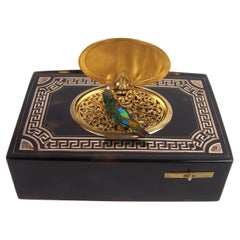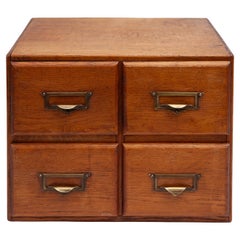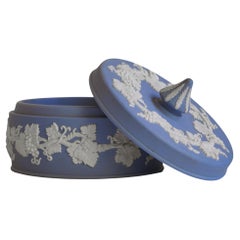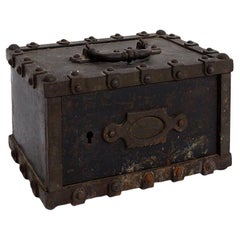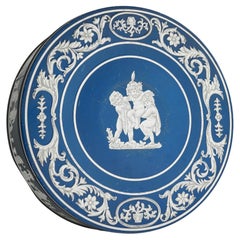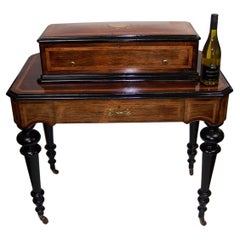Benelux - Boxes
to
29
375
5
3
46
171
158
8
56
70
17
8
3
8
10
2
9
14
10
2
41
30
21
20
13
8
4
4
3
2
2
2
2
2
1
1
213
204
62
53
41
383
5,257
4,655
297
95
61
41
36
Height
to
Width
to
383
382
382
12
4
4
3
3
Item Ships From: Benelux
Singing bird box by Jacques Bruguier tortoiseshell case with enameled lid
Located in Zonhoven, BE
Very rare singing bird box by Jacques Bruguier, made in Geneva circa 1850.
When activated, the lid opens and a finely crafted bird rises from a beautifully pierced and engraved grill...
Category
Late 19th Century Swiss Late Victorian Antique Benelux - Boxes
Materials
Metal, Silver, Enamel, Other
Archive Four Drawer Desk Cabinet, 1930s
Located in Antwerp, BE
Vintage Industrial compact four drawer Oak archive cabinet, storage desk organizer, 1930s. Dimensions:H.30cm-W.40-D.60 cm
Category
1930s French Industrial Vintage Benelux - Boxes
Materials
Brass
Wedgwood Jasperware Lidded Box with Blue and White Decor
By Wedgwood
Located in Meer, VAN
Wedgwood Jasperware Lidded box, England, 20th century. This is a quintessential piece of Wedgwood Jasperware. Lidded box in the famous Jasperware blue and white decor. Neo-classic...
Category
Mid-20th Century Benelux - Boxes
Materials
Ceramic, Stoneware
Antique Bauche Incombustible Cast Iron Safe from Northeastern France, 1865
Located in Linkebeek, BE
19th century non-combustible cast-iron travel strongbox by Bauche-Fichet, France
Antique travel safe in non-combustible cast iron from northeastern France (Gueux, Marne).
It is decor...
Category
Mid-19th Century French Napoleon III Antique Benelux - Boxes
Materials
Iron
Huntley Boorne & Stevens Mid Century ‘Wedgwood Jasperware’ Biscuit Tin 1950s
By Piero Fornasetti, Wedgwood
Located in Meer, VAN
Huntley Boorne & Stevens Mid Century ‘Wedgwood Jasperware’ Biscuit Tin, England, mid 20th century. This is a very decorative biscuit tin by Huntley Boorne & Stevens, one of ...
Category
Mid-20th Century Neoclassical Benelux - Boxes
Materials
Metal
interchangeble 6 cylinder music box playing 36 tunes
Located in Zonhoven, BE
Music box on matching table – 6 cylinders with 6 melodies each
Beautiful Swiss music box, crafted in the late 19th century, presented on its original matching table.
The set includes...
Category
Late 19th Century Swiss Late Victorian Antique Benelux - Boxes
Materials
Bronze, Steel, Cut Steel, Other, Iron
19th Century Dutch Silver Box by Willem van Baren, Schoonhoven, 1886
Located in Delft, NL
19th century Dutch silver box by Willem van Baren, Schoonhoven, 1886
A silver box with a hinged lid. The handle of the lid are 2 dolphins. The reli...
Category
19th Century Dutch Antique Benelux - Boxes
Materials
Silver
Late 19th Century Wooden Cigar Carrousel with Music
Located in Casteren, Noord-Brabant
A beautiful antique wooden cigar carousel, with music.
Made in France, late 19th century. When you turn the knob on the top, all panels turn at the same time. The panels are hand-pai...
Category
1880s French Napoleon III Antique Benelux - Boxes
Materials
Brass
Griebaum singing bird box from the 1950s-60s
By Karl Griesbaum
Located in Zonhoven, BE
Beautiful Singing Bird by Karl Griesbaum
A unique masterpiece from the 1950s or 1960s, crafted by the renowned Karl Griesbaum in Germany.
When activated, a bird elegantly emerges, ...
Category
Mid-20th Century German Late Victorian Benelux - Boxes
Materials
Metal, Other
Very Decorative Box in Patinated Cognac Leather and Metal Studs 1950s
Located in Meer, VAN
Very Decorative Box in Leather and Metal Studs, Europe, 1950s.
This mid-century decorative box is clad in warm brown leather and features intricate stud detailing. The box has a dom...
Category
Mid-20th Century European Mid-Century Modern Benelux - Boxes
Materials
Metal
Antique 19th century English Mahogany veneered leather inlaid brown writing box
Located in Casteren, NL
On offer here is an elegant English mahogany writing box dating back to the late 19th century, around 1880. The box, with gently rounded upper corners, was crafted from solid pine wood and then veneered with rich mahogany. At the center of the lid, there is an inlaid oval piece of mother-of-pearl, complemented by a matching mother-of-pearl escutcheon surrounding the keyhole. The box retains its original hinges, locks, and key, all in excellent working condition.
When opened, this sophisticated writing box reveals a sloped leather writing surface, crafted from green-dyed sheepskin leather and adorned with a decorative gold-leaf border. The writing surface folds open on both sides, offering hidden storage space beneath for letters and documents.
This writing box has been gently cleaned in our workshop, ensuring it is pristine, complete, and fully functional—a timeless piece of craftsmanship ready to be admired and used.
An English mahogany writing box, also known as a writing slope or lap desk, has a rich history dating back to the 18th century. These portable writing desks were essential for both personal and professional use, especially during a time when travel and correspondence were becoming increasingly important.
Initially, writing boxes were made from oak and often featured intricate carvings. However, by the late 18th century, mahogany became the preferred material due to its durability and attractive appearance[1]. These boxes were designed to be both functional and stylish, often featuring brass fittings, secret...
Category
19th Century English Antique Benelux - Boxes
Materials
Mahogany
19th Century Victorian Jewelry Box
Located in Casteren, Noord-Brabant
Beautiful antique Victorian jewelery box. The box is made of wood, covered with paper machee, lacquered black and inlaid with a mosaic of mother-of-pearl. Painted with gold colored decorations. The interior of the box is lined with blue silk fabric...
Category
1880s British Victorian Antique Benelux - Boxes
Materials
Wood, Paper
Griesbaum singing bird box in decoratieve painted box from the 1950s-60s
By Karl Griesbaum
Located in Zonhoven, BE
Griesbaum singing Bird Box
A stunning bird box in a uniquely painted case, showcasing fine craftsmanship and elegance.
The mechanism is wound from the bottom, and with a simple slide...
Category
Mid-20th Century German Late Victorian Benelux - Boxes
Materials
Metal, Other
Antique Black forest Cigar box / Humidor 19th Century carved deer Walnut Swiss
Located in Ijzendijke, NL
Rare and impressive, this 19th-century hand-carved Swiss Black Forest cigar box is crafted from rich walnut, offering a stunning patina that has developed over nearly 150 years. The ...
Category
Late 19th Century Swiss Black Forest Antique Benelux - Boxes
Materials
Wood
Ottaviani Mid Century Sterling silver enamel and wood playing card box
By Ottaviani
Located in Antwerp, BE
Mid Century Sterling silver enamel and wood playing card box, Italy 1979.
Signed Ottaviani, Sterling silver 925 mark.
Complete set ...
Category
Mid-20th Century Italian Mid-Century Modern Benelux - Boxes
Materials
Sterling Silver, Enamel
Hermès Box by Paul Dupré-Lafon, France 1930-1940
By Hermès
Located in Delft, NL
Hermès Box by Paul Dupré-Lafon, France 1930-1940
French Box by Paul Dupré-Lafon for Hermès Paris, 1930-1940
Paul Dupré-Lafon (1900-1971)
Hermès Paris lidded box with leather in cogn...
Category
20th Century French Benelux - Boxes
Materials
Leather
Antique Swedish Large Wooden storage box 1800's Handmade Folk Craft
Located in Forest, BE
Swedish antique pine and birch wooden storage box. The lady’s got them to store there small goods at the wedding. Fine quality of bentwood. It is a true piece from the early 19 cen...
Category
Early 19th Century Swedish Folk Art Antique Benelux - Boxes
Materials
Birch, Pine
small mother-of-pearl box
Located in Brussels, BE
small mother-of-pearl box
Category
21st Century and Contemporary French Benelux - Boxes
Materials
Mother-of-Pearl, Wood
19th Century Napoleon III Game Box
Located in Casteren, Noord-Brabant
Beautiful antique wooden game box from the French Napoleon III period. The wood is inlaid with a brass emblem and brass piping, this gold color contr...
Category
1870s French Napoleon III Antique Benelux - Boxes
Materials
Brass
“Tout ou Rien” (“All or Nothing”) by Line Vautrin, silvered bronze box.
By Line Vautrin
Located in Uccle, BE
“Tout ou Rien” (“All or Nothing”) by Line Vautrin, silvered bronze box.
A “toutou” in familiar french language is a dog. It’s inscribed “RIEN” on the necklace, introducing the expres...
Category
Mid-20th Century French Mid-Century Modern Benelux - Boxes
Materials
Bronze
Late 19th Century Napoleon III Bombay Wood Marquetry Tea Caddy
Located in Casteren, Noord-Brabant
An antique French tea caddy in Napoleon III style, wit a bended “forme arbalète” lid. The box is veneered with various types of wood, burl wal...
Category
1860s French Napoleon III Antique Benelux - Boxes
Materials
Brass
Antique Tramp Art Box with Mirrors Folk Art Collectible
Located in Poperinge, BE
Beautiful antique tramp art box with mirrored panels on the sides and top, pointed feet and a triangular lid, partly covered with green velvet inside and decorated with a small mirro...
Category
Early 20th Century European Folk Art Benelux - Boxes
Materials
Mirror, Wood
Brass walnut shaped nut cracker , 1970’s
Located in Delft, NL
Brass walnut shaped nut cracker , 1970’s
Category
1970s German Mid-Century Modern Vintage Benelux - Boxes
Materials
Brass
Dutch silver lidded box with 17th century scenes by Jan Steen
Located in Delft, NL
Dutch silver lidded box with 17th century scenes by Jan Steen
A large Dutch silver box with a high round lid, raised on four legs of dolphins. The box decorated in high relief with ...
Category
Early 20th Century Dutch Benelux - Boxes
Materials
Silver
Large Vintage Brass Crab Sculpture-Box
Located in Brussel, BE
Large vintage crab shape box made of solid heavy brass with a beautiful natural patina, a unique touch in an eclectic interior, a cabinet of curiosity or seafood restaurant.
-
Grande...
Category
20th Century Benelux - Boxes
Materials
Brass
$1,078 / item
19th Century Napoleon III Game Box with Burl Wood and Brass
Located in Casteren, Noord-Brabant
Beautiful antique game box from the French Napoleon III period. The box is made of book veneer match, inlaid with brass trims. This box shows the fine craftsmanship of the ebenist wh...
Category
1870s French Napoleon III Antique Benelux - Boxes
Materials
Brass
Three MCM Italian Alabaster and Brass Claw Dolphin Footed Lidded Jewelry Boxes
Located in Haarlem, NL
Set of three hand carved Italian alabaster claw and dolphin footed decorative boxes in blue, orange and beige coloured alabaster.
I fell in love with their beautiful shiny colours and the heaviness of the material of these jewellery boxes with hinged lids, brass claw feet, brass dolphin feet...
Category
1960s Italian Mid-Century Modern Vintage Benelux - Boxes
Materials
Alabaster, Brass
$760 Sale Price / set
20% Off
Antique Incombustible Cast Iron Safe
Located in Linkebeek, BE
Antique Incombustible Cast Iron Safe
Safe - Antique - Coffre-fort
Measures : 50x33cm H:38cm
Wear consistent with age and use : See Photos
Category
20th Century Industrial Benelux - Boxes
Materials
Iron
Rare Antique 4 Tier Black Forest Jewelry Box Fruitwood 19th Century Hand Carved
Located in Ijzendijke, NL
A beautiful, very finely carved antique black forest jewelry box from the late 19th/ early 20th century made in Switzerland.
A large and impressive four-tiered piece with 6 swing o...
Category
1880s Swiss Black Forest Antique Benelux - Boxes
Materials
Fruitwood
Singing bird box by Bruguier in silver case with enamel to top and lid
Located in Zonhoven, BE
Rectangular silver guilded case with rounded corners.
The oval lid has an enamel painting on the exterior of a mountain view and on the interior brightly enamelled with flower bouqu...
Category
Mid-19th Century Swiss Late Victorian Antique Benelux - Boxes
Materials
Metal, Silver, Enamel, Other
Alfred Daguet, Paris, Art Nouveau Embossed Brass & Inlaid Glass Cabochons Box
By Alfred Daguet
Located in Lisse, NL
One of a kind and all hand-crafted, good size antique box by Alfred Daguet (1875-1942).
Alfred Daguet was a French craftsman/metalsmith, active around the early 1900s and who specia...
Category
Early 20th Century French Arts and Crafts Benelux - Boxes
Materials
Brass, Copper
English silver horse racing snuff box, Birmingham 1829
Located in Delft, NL
English silver horse racing snuff box, Birmingham 1829
A silver snuff box with a scene from horse racing on top of the hinged lidded box. On the sides a guilocche pattern and inside...
Category
Early 19th Century English Antique Benelux - Boxes
Materials
Silver
Late 19th Century English Game Box
Located in Casteren, Noord-Brabant
Lovely antique game box, made of mahogany.
The box contains several games, with many bits and pieces. Not all complete.
It is obviously that there h...
Category
1890s British Belle Époque Antique Benelux - Boxes
Materials
Wood
Rare 2 tier Swiss 19th century Black Forest Jewelry box hand carved Fox & bird.
Located in Ijzendijke, NL
This incredibly rare two-tier Swiss Black Forest jewelry box is fully hand-carved from a single block of wood, making it a true masterpiece. What sets this box apart is its unique de...
Category
Late 19th Century Swiss Black Forest Antique Benelux - Boxes
Materials
Velvet, Wood
Automaton singing bird by Bontems
By Bontems
Located in Zonhoven, BE
Unique flower pot with singing bird automaton made by Bontems in the last quarter of the 19th century.
Bontems was a manufacturer of bird automatons in Paris. He produced decent num...
Category
Late 19th Century French Late Victorian Antique Benelux - Boxes
Materials
Metal, Gold Plate, Other
Vanity Case with Crystal Boxes and Sterling Silver Lids by George Betjemann 1870
By George Betjemann & Sons
Located in Casteren, Noord-Brabant
Beautiful feathered walnut, brass bound, vanity box by the famous makers “Betjemann & Sons” of London. This vanity box has several compartments and the attention to detail is fabulou...
Category
1870s English Victorian Antique Benelux - Boxes
Materials
Wood
Duccommun Girod 6 tune music box with exposed controls
Located in Zonhoven, BE
EEarly and exceptional music box by Ducommun Girod with "exposed contols"
Ducommun Girod was one of the first manufacturers of music boxes early in the 19th century. He is known for...
Category
Early 19th Century Swiss Early Victorian Antique Benelux - Boxes
Materials
Bronze, Steel, Cut Steel, Other, Iron
$4,696 Sale Price
20% Off
Antique Swedish flour Wooden storage box 1800's Handmade Folk Craft blue painted
Located in Forest, BE
Swedish antique pine and birch wooden flour box. All made by hand, the lid is perfectly adjusted to the barrel. Fine quality of bentwood. It is a true piece from the late 18 century ...
Category
Early 19th Century Swedish Folk Art Antique Benelux - Boxes
Materials
Birch, Pine
Tea Caddy - Elie Bleu Paris
By Elie Bleu
Located in Casteren, Noord-Brabant
A beautiful vintage tea caddy, made by the French brand Elie Bleu Paris.
The box is made of beautifully veneered / greened wood with black piping. Th...
Category
Early 2000s French Modern Benelux - Boxes
Materials
Silver Plate
Singing Bird Cage with 2 birds by Bontems
By Bontems
Located in Zonhoven, BE
Rare and very decorative singing bird automaton.
Made in de 4th quarter of the 19th century by Bontems in Paris (France).
This singing bird cage has a brass gilded base to conseal ...
Category
Late 19th Century French Late Victorian Antique Benelux - Boxes
Materials
Metal, Gold Plate, Other
Stunning Little Antique Box with Decorated and Gilt Perfume Bottles Napoleon III
Located in Lisse, NL
If you are looking for the perfect gift for a lady. . .look no further.
This magnificent, 19th century box is made of beautiful and mint condition boxwood and it comes with the original, gilt perfume...
Category
Late 19th Century French Napoleon III Antique Benelux - Boxes
Materials
Crystal
Rare enamel bread bin with honeycomb pattern, Germany 1910s
Located in Meulebeke, BE
Germany / 1910 / bread bin / enamel / Art Nouveau / Vintage / Antique
Art Nouveau lunch box or bread bin made in Germany around 1910. Decorated with white and blue honeycomb pattern and the written on top: Unser tägliches Brot gib uns heute (give us our daily bread...
Category
Early 20th Century German Art Nouveau Benelux - Boxes
Materials
Metal, Enamel
Antique French liquer cellar, cabinet “Cave a liqueur”
Located in Delft, NL
Antique French liquer cellar, cabinet “Cave a liqueur”
An antique French book-shaped lidded liquer cellar cabinet, also called “Cave a liqueur”. A liqueur cellar hidden in 18th cent...
Category
19th Century French Antique Benelux - Boxes
Materials
Leather, Wood
Rare collection 5 Antique Ceramic Tobacco Jars Humidors Figural, Bernard Bloch
By Bernhard Bloch
Located in Gorssel, GE
Rare collection of 5 antique ceramic tobacco jars/humidors.
1. Hand-painted cermic tobacco jar, marked underside illegible and numbered 8100, man with cap with inscription 'Polin' ...
Category
1890s Austrian Antique Benelux - Boxes
Materials
Ceramic
$1,752 Sale Price / item
25% Off
19th Century Japanese Style Storage Box - Bamboo and Copper
Located in Casteren, Noord-Brabant
A beautiful antique storage box, made of bamboo, beautifully decorated with plates of gracefully embossed copper.
The chest was probably made in Japan, for the European/French market...
Category
1890s Japanese Chinoiserie Antique Benelux - Boxes
Materials
Copper
Wooden casket with polychrome and gilded "pastiglia" relief decor, Italy 15th c.
Located in Gorssel, GE
A rare wooden casket with polychrome and gilded pastiglia relief, Italy, 15th century.
The box is adorned with four finely executed scenes from the life of an unknown martyr — beautifully preserved and remarkably vivid after centuries.
Dimensions: 15.5 × 10.4 × 9 cm
Provenance: Dutch private collection
In overall good condition for its age, with minor losses to the surface and possible retouching to the polychromy. The ball feet are likely later additions.
Pastiglia [paˈstiʎʎa], an Italian term meaning "pastework", is low relief decoration, normally modelled in gesso or white lead, applied to build up a surface that may then be gilded or painted, or left plain. The technique was used in a variety of ways in Italy during the Renaissance.
White lead pastiglia was a north Italian speciality, produced between about 1450 and 1550. Six workshops were identified by Patrick M. De Winter, although their location remains uncertain; the Workshop of the Love and Moral Themes, whose products seem the most numerous, was possibly at Ferrara, where the painter Cosimo Tura began his career gilding caskets. Venice is also thought to have produced them. Other workshops identified by De Winter include the "Workshop of the main Berlin casket" and "Workshop of the Cleveland Casket".
The subjects were typically classical, drawn from both mythology and Ancient Roman history (especially the early period covered by Livy), but biblical ones are also found. Compositions can often be shown to be borrowed from another medium, such as prints or bronze plaquettes...
Category
15th Century and Earlier Italian Renaissance Antique Benelux - Boxes
Materials
Gesso, Wood
Antique China Wood Pencil Box Chicken Cock Figth Imerial Court Scene Top, 18th C
Located in Amsterdam, Noord Holland
Antique China Wood Pencil Box Chicken Cock Figth Imerial Court Scene Top, 18th C
Beautifully painted.
Additional information:
Material: Wood
Type: Box
Region of Origin: China
Date...
Category
18th Century Chinese Antique Benelux - Boxes
Materials
Wood
$398 Sale Price
20% Off
Late 19th Century Napoleon III Ebonized Cigar Cabinet
Located in Casteren, Noord-Brabant
A stylish Napoleon III cigar cabinet, crafted with ebonized wood, brass inlays, and a distinctive medallion at the top, this late 1800s piece reflects the refined style of the Napole...
Category
1870s French Napoleon III Antique Benelux - Boxes
Materials
Brass
Dutch silver pill box, 1869
Located in Delft, NL
Dutch silver pill box, 1869
A Dutch silver small cartouche-shaped pill box with engraved floral decor on the lid. The silver box has a hinged lid. The box is Dutch silver hallmarked...
Category
19th Century Dutch Antique Benelux - Boxes
Materials
Silver
Stunning Handcrafted Late 1800s Gothic Casket with Peacock & Gargoyle Sculptures
Located in Lisse, NL
Beautiful and rare Gothic Revival treasure box with bronze handle.
If you are a collector of antique boxes and/or if you are looking for an extraordinary jewelry box to grace your credenza or side table then this unique and top quality made specimen in the Gothic style could be perfect. Gothic Revival boxes are very hard to find and we have never seen one with such prodigious carvings on all sides. The unique and cat-like dragon gargoyles (with fangs) that look like they are carrying this casket, are just some of the stunningly carved and detailed sculptures that make this antique rarity even more artistic and impressive.
Another great feature are the peacock sculptures. In Christianity the peacock is the symbol of purity. Christians believe that once someone has passed their soul rises and goes to heaven. This is why in earlier times Christians would spread the feathers of a peacock over the deceased since it symbolized a pure soul that was immune to corruption. The peacock also represents immortality, resurrection, and the spiritual teachings of Jesus Christ and the Christian church.
Have you also noticed the top quality details on both ends of the bronze handle on top? The quality of that ornamental work is of the absolute highest standard also. There are many more incredibly beautiful, hand carved details and together they show that no expense was spared to create one of the most amazing Gothic caskets...
Category
Late 19th Century Italian Gothic Antique Benelux - Boxes
Materials
Bronze, Iron
Antique Swedish Wooden barrel 1800's Handmade Folk Craft great condition
Located in Forest, BE
Swedish antique pine hand crafted wooden barrel. Made to be used as a washing basin or a grain storage. Fine quality of bentwood. It is a true piece from the early 19 century. Beaut...
Category
Early 19th Century Swedish Folk Art Antique Benelux - Boxes
Materials
Birch, Pine
Late 19th Century Oak with Copper Mounts Storage Chest
Located in Casteren, Noord-Brabant
A beautiful decorative storage chest. The chest is made of solid oak. At the front, top and both sides a copper diamond pattern with flower motifs. On both side brass handles. Made i...
Category
1890s French Antique Benelux - Boxes
Materials
Copper
Embriachi workshop marquetry casket - Northern Italy, 15th century
Located in Bruxelles, BE
Embriachi workshop marquetry casket
Northern Italy, 15th century
Alla certosina inlays (bone, stained bone, pewter and wood)
H 28.2 x W 18 x D 14 cm
This beautiful casket of rectangular form is richly decorated with the characteristic geometric patterns of the Embriachi style.
The intricate geometric patterns are fashioned by juxtaposing lighter and darker pieces of wood, (colored) bone, horn and pewter. The lid and base are framed by a broad band of horn. When ivory became scarce in Europe due to disrupted trade routes, bone was substituted.
The attention to Symmetry and balance created an harmonious visual effect
Enhancing the overall aesthetic appeal of the casket.
The application of geometrical motifs is in Italy known as marquetry ‘alla Certosina’, named after the Certosina Church in Pavia with its famous altarpiece decorated in this way. This is ‘intarsia technique’, a term derived from the Arabic 'tarsi', which means ‘incrustation' recalling ancient mosaics made from various materials.
These geometric elements not only enhance the aesthetic appeal of the caskets but also demonstrate the versatility and skill of the artisans in creating multifaceted works of art.
‘Alla Certosina’ became famous through the Northern Italian Embriachi family who achieved a particularly high standard in working in this technique. Venice in particular was known for the production of these luxurious boxes. The caskets, hexagonal or rectangular, surmounted by a lid decorated in several registers constitute the secular, albeit equally renowned component of the workshop’s production, in addition to mirror frames and various everyday objects.
The method of fabrication of those objects was based on two concepts that underlay pre-industrial production: standardization and modularity, thanks to a distribution of skills according to the different phases of fabrication.
even the realization of the marquetry motifs (in the form of ingots from which portions of the desired size were cut) were therefore entrusted to various specialized craftsmen, as were the assembly phase.
Today better known thanks to the extensive research work recently carried out by Michele Tomasi, this workshop owes its name to its founder and owner, the Florentine Baldassare Ubriachi (or degli Embriachi), a merchant and banker established in the Tuscan capital before he settled in Venice in 1395. Together with sculptor Giovanni di Jacopo, who directed the workshop, from the last years of the fourteenth century, Baldassare oversaw a production that was truly original, and still easily recognizable today, comprising monumental altarpieces and various objects, primarily triptychs and caskets.
The precise location of the workshop is unknown, except that it originated in Florence and in ca. 1431 there was apparently a workshop in Venice, in the area of S Luca. They employed local workers specializing in 'certosina' (inlay of stained woods, bone and horn), and the workshop produced items carved in bone (usually horse or ox) with wood and bone marquetry.
The geometric decoration of Embriachi caskets reflects the artistic complexity and attention to detail that characterized their work.
this inlaid casket is a testament to the skill and artistry of the Embriachi family and serves as a stunning example of the decorative arts of the late Middle Ages.
Related Literature :
E. Berger, Prunk-Kassetten: Europäischen Meisterwerke aus acht Jahrhunderten / Ornamental Caskets...
Category
15th Century and Earlier Italian Renaissance Antique Benelux - Boxes
Materials
Pewter
$20,368 Sale Price
22% Off
Antique Black Forest 19th Century Jewelry Box Carved Fruitwood Red Velvet Chest
Located in Ijzendijke, NL
Gorgeous & Breathtaking! This small 19th century Black Forest Jewellery Box carved out of fruit wood.
Carved by a master carver with attention to detail decorated on the top, front ...
Category
Late 19th Century Swiss Black Forest Antique Benelux - Boxes
Materials
Velvet, Wood
Hanau Silver Jewelry Box J.D.Schleissner and Sons Antique German Casket Putto
By J.D. Schleissner & Söhne 1
Located in Wommelgem, VAN
A 19th century Hanau sterling silver presentation box or jewelry box with hinged cover.
Large 800 silver box of quatrefoil form, impre...
Category
19th Century German Rococo Revival Antique Benelux - Boxes
Materials
Sterling Silver
French Ormolu Mother of Pearl Egg Shaped Enamel Perfume Bottles in Box
Located in Delft, NL
French 19th century Ormolu mother of pearl egg shaped perfume box on foot
A beautiful egg shaped perfume bottle box, with interior of 2 perfume bottles wh...
Category
19th Century French Antique Benelux - Boxes
Materials
Ormolu
19th Century Decorative Box - Ormolu Gilt Bronze - French Napoleon III
Located in Casteren, Noord-Brabant
A refined Napoleon III period decorative box, made of ormolu gilt casted bronze. Richly ornate floral motifs. It has an illegible signature. The liner inside has been renewed. Includ...
Category
1860s French Napoleon III Antique Benelux - Boxes
Materials
Bronze, Ormolu
Japanese Kobako Yosegi Zaiku marquetry roll-top box
Located in Delft, NL
Japanese Kobako Yosegi Zaiku marquetry roll-top box
A Japanese Kobako box, small and very light box with a roll-top door. A box, designed with beautiful Yosegi Zaiku inlay work (marquetry). Made in the Hakone region
Hakone-Yosegi-Zaiku is a type of traditional Japanese inlay...
Category
20th Century Japanese Benelux - Boxes
Materials
Fruitwood
Exquisite 19th Century antique Swiss fully hand carved Black forest Jewelry box
Located in Ijzendijke, NL
A true masterpiece, this fully hand-carved 19th-century Black Forest jewelry box from Switzerland is a remarkable work of art. Nearly 150 years old, the wood has developed an extraor...
Category
Late 19th Century Swiss Black Forest Antique Benelux - Boxes
Materials
Velvet, Wood
Perfect Antique Chinese Cloissone Box Qing Period Bronze, 19th/20th Century
Located in Amsterdam, Noord Holland
Perfect Antique Chinese Cloissone Box Qing Period Bronze, 19th/20th Century
Great piece of cloisonne.
Additional information:
Material: Porcelain &...
Category
19th Century Chinese Antique Benelux - Boxes
Materials
Porcelain
Recently Viewed
View AllMore Ways To Browse
Regency Penwork
Hermes Cigarette
Mid Century Stone Black And White Box Boxes
Moser Glass Box
Heart Shaped Silver Box
Madagascar Rosewood
Moroccan Inlaid Box
Paul Evans Box
Middle Eastern Mosaic Inlaid Jewelry Box
Porcelain Heart Boxes
Roman Mosaic Panel
Iron Strongbox
Malachite Trinket
Moroccan Inlay Box
Safe Strongbox
Bone Inlay Tray
Capodimonte Box
Chinese Food Boxes
